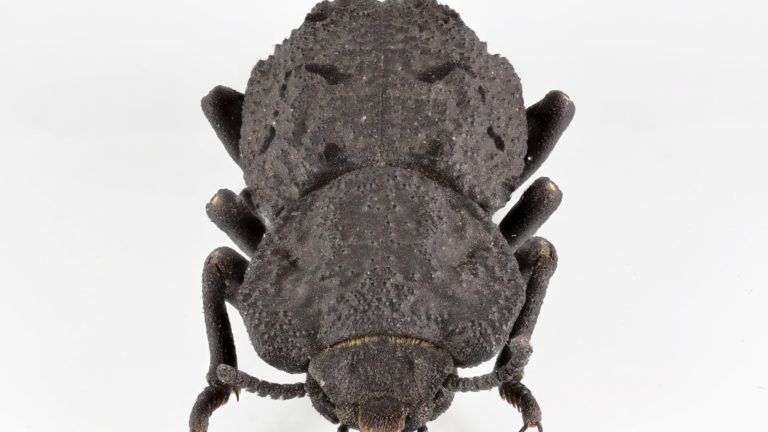The key to making stronger buildings and planes could lie in the anatomy of a crush-resistant insect that can survive being run over by a car, scientists have found.
To understand the secret behind the impressive strength of the inch-long diabolical ironclad beetle, researchers tested how much squishing it could take - and discovered it could handle about 39,000 times its own weight.
The study, led by engineers at the University of California, Irvine (UCI) and Purdue University, found the insect has two armour-like elytron that meet at a line, called a suture, which runs through the abdomen.
This unusual structure is layered and pieced together like a jigsaw, said Purdue civil engineer Pablo Zavattieri, who was part of a group of researchers that used CT scans to inspect the insect and run it over with a car.
He explained that when compressed, it fractured slowly instead of snapping.
"When you pull them apart, it doesn't break catastrophically. It just deforms a little bit," he said.
"This beetle is really tough."
The exoskeleton is thought to be one of the toughest structures known to exist in the animal kingdom.
Another lead researcher and engineering professor David Kisailus told Sky News the findings could inspire stronger structures and vehicles that are made with materials such as steel, plastic and plaster.
"For instance, current aircrafts are moving towards composite materials and... if it is 50% composite then the other components are other materials," he said.
"So how do you join those together? Firstly, if you can make your aircraft more lightweight it's using less fuel and less CO2 emissions, but secondly you allow more safety protocols because the beetle structure provides about 105% more toughness, so there'll be less failure of materials."
The potential shift from using strong, brittle materials to ones that can be both strong and tough by dissolving energy as they break could also make buildings safer, he explained.
That's because engineers currently rely on pins, bolts, welding and adhesives to hold everything together - techniques vulnerable to degrading.
"Any structural material that is going to be joined - indeed if you had connections in bridges where you need to have slight expansion and contraction - currently they don't have the same micro-layered structures as the beetle, so this could enhance reliability and avoid catastrophic failure," Professor Kisailus said.
Diabolical ironclad beetles are commonly found in Southern California's woodlands and can withstand pressure such as bird pecks and animal stomps.
Other local beetles were crushed by a third of the weight it could hold, previous research had found.
The study, published in Nature, is part of an $8m project funded by the US Air Force to explore how the biology of creatures such as mantis shrimp and bighorn sheep could help develop impact-resistant materials.
Brown University evolutionary biologist Colin Donihue, who was not involved in the study, said it was the latest effort to solve human problems with secrets from the natural world.
Velcro, for example, was inspired by the hook-like structure of plant burrs, while artificial adhesives took a page from super-clingy gecko feet.
Professor Donihue said endless other traits found in nature, or "adaptions which have evolved over millenia," could offer scientific insight.




